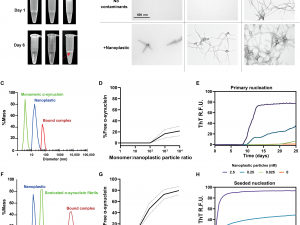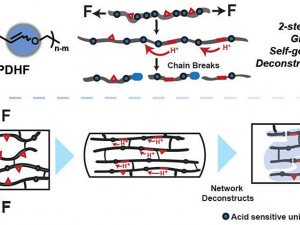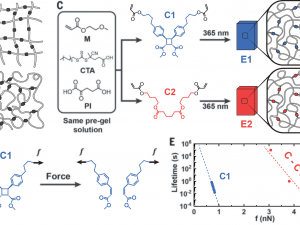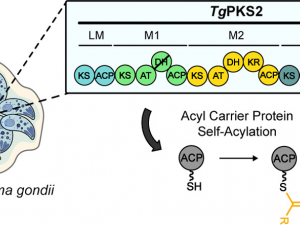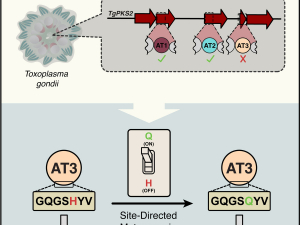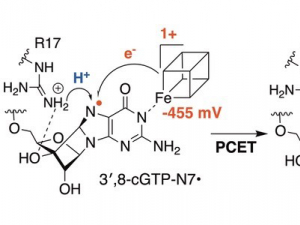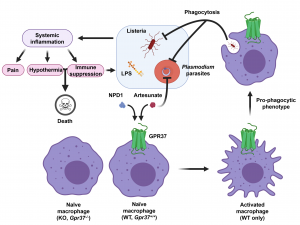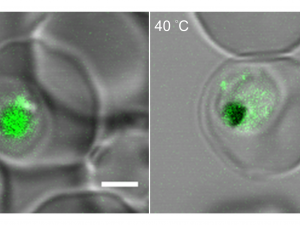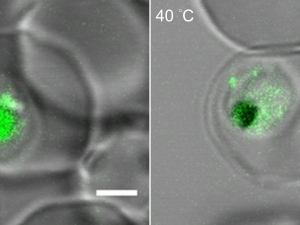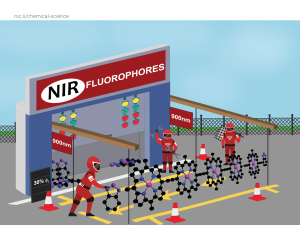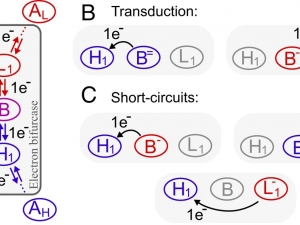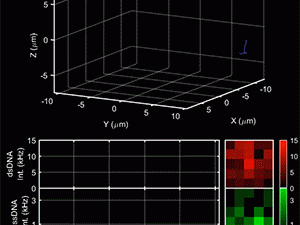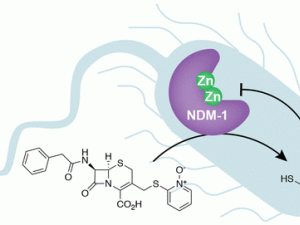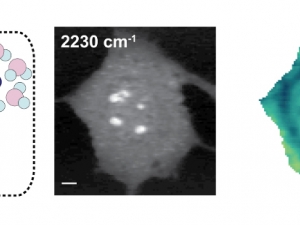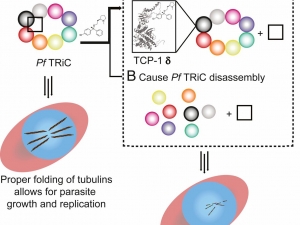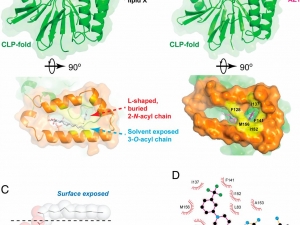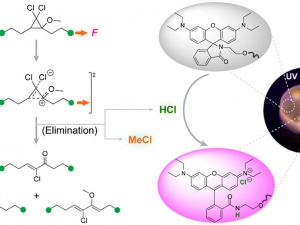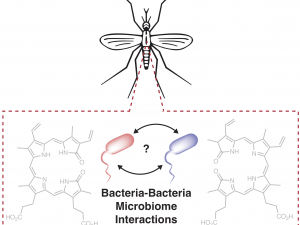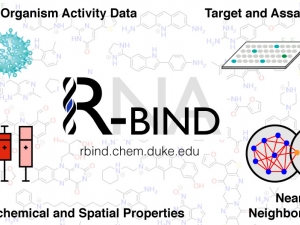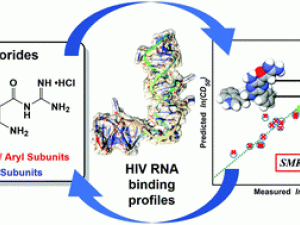Of the fastest growing neurological disorders in the world, Parkinson’s disease is pathologically defined by the accumulation of the protein α-synuclein in vulnerable neurons in the brain. Prolonged exposure to environmental challenges of largely unknown origins are suspected as principal driving factors for disease risk and progression. The increase in polystyrene nanoplastics in the environment from single-use plastics, recent detection of polystyrene contaminants in blood, and reports of anionic polystyrene… read more about Do the toxins of anionic nanoplastics have a possible role in Parkinson’s disease risk and progression? »
Work from the Craig lab shows how embedded mechanophores can be used to transduce mechanical force into triggered polymer network deconstruction. The paper, "Mechanically Triggered Polymer Deconstruction through Mechanoacid Generation and Catalytic Enol Ether Hydrolysis," is available at J. Am. Chem. Soc. read more about Craig Lab Continues to Expand the Utility of Responsive Polymers »
The Malcolmson lab has developed a three component carboamination of dienes utilizing aliphatic and aryl amines in conjunction with alkenyl electrophiles. Two different Pd-based catalysts allow for regiodivergent introduction of the amine reagent. The multicomponent coupling, together with the regiodivergence, enables the rapid production of a library of small molecule building blocks to facilitate drug discovery. Mechanistic experiments suggest the origin of regioselectivity with both catalysts, including a key pi-stacking… read more about Malcolmson Lab Develops Catalytic Three Component Regiodivergent Reactions to Prepare Allylic Alkyl Amines »
A study by the Craig lab and collaborators provides a blueprint for rewriting historical performance rules for materials made from polymer networks. Adding a small fraction of reactive groups in the right places within conventional networks can make the materials about 10 times more difficult to tear, and systematic studies uncover a physical picture at the heart of the phenomenon. Read here for more information: https://www.science.org/doi/full/10.1126/science.adg3229 read more about Embedding reactive bonds leads to less breakable materials »
How do parasites make natural products? A new study by the Derbyshire lab resolved a polyketide synthase present in Toxoplasma gondii and observed an unexpected self-acylation activity with acyl carrier proteins within this system. Their findings suggest a potential regulatory mechanism and may help identify the metabolite(s) being made by the parasite in future studies. You can read more about their work in a recent ACS Chemical Biology issue, available here. read more about Derbyshire Lab May Help Identify the Metabolite(s) Being Made by Parasites »
The Derbyshire lab has recently published a research article in Cell iScience investigating the activity of acyltransferase (AT) domains in a polyketide synthase from the apicomplexan parasite Toxoplasma gondii. Their work identifies a single amino acid in these domains responsible for protein activity which was able to be controlled through mutational studies, effectively serving as an "on-off" switch for AT activity. Read more about their exciting work here! read more about Derbyshire Lab investigates the activity of AT domains from the parasite Toxoplasma gondii »
COVID19 cases are receding in some parts of the world but surging in other parts, especially those with limited access to vaccines, ultimately making the entire world population a vulnerable prey of the constantly emerging new variants. In a recent Science Advances publication, Martina Zafferani of the Hargrove Lab and collaborators tackled the problem by developing antivirals that take direct aim at SARS-CoV-2 RNA structure. They identified amiloride derivatives that can… read more about Coronavirus's Tangled Strands of RNA Could Offer New Ways to Treat People Who Get Infected »
A collaboration between the Yokoyama and Yang Labs has led to a publication of their latest work on the catalytic mechanism of MoaA radical SAM cyclase in molybdenum cofactor biosynthesis. In this work, combined efforts using electrochemistry, EPR spectroscopy, and DFT calculation provided evidence that the reduction of the aminyl radical intermediate proceeds by a proton-coupled electron transfer (PCET) with a 4Fe-4S cluster as an electron donor. The EPR also revealed an electronic coupling between GTP and… read more about Yokoyama and Yang Labs collaborate to find insights into the radical quenching step of radical SAM enzyme catalysis »
Dr. Pengfei Zhou of the Malcolmson Lab, in collaboration with former Malcolmson Lab postdoc Dr. Xinxin Shao, now an assistant professor at Hangzhou Normal University, have developed a new reagent class, 2-azatrienes, that enables the diastereodivergent and enantioselective synthesis of allylic 1,2-diamines through copper-catalyzed reductive couplings with imines. Both syn- and anti-diamines are key fragments in a number of potent bioactive molecules and are each formed selectively in their respective CuH-… read more about Malcolmson Lab Develops a New Reagent for Diastereodivergent and Enantioselective Synthesis of Allylic Amines »
Recent work from the Ji (Department of Anesthesiology at Duke) and Derbyshire labs has led to the unexpected discovery that artesunate, a front-line antimalarial, confers protection against infection-induced sepsis and pain-like behavior in mice. Artesunate has been used for decades in the clinic, and while its potent anti-plasmodium activity has been widely studied, little is known about its interactions with host cells. While studying the possible role of the human orphan GPCR GPR37, they found that GPR37 agonists may… read more about Derbyshire Lab Making Strides Toward Treating Malaria »
A recent collaborative effort between the Derbyshire lab at Duke and Prof. Jacquin Niles’ lab at the Massachusetts Institute of Technology discovered a mechanism that helps Plasmodium falciparum parasites survive hostile thermal conditions recapitulating malaria fever. The study shows that P. falciparum, the deadliest of the human malaria parasites, uses the lipid PI(3)P and heat shock protein 70 to stabilize the parasite’s digestive vacuole under heat stress. Read more about their discovery… read more about Derbyshire Lab Illuminates How Malaria Parasites Withstand Feverish Temperatures »
The Therien lab studied highly conjugated porphyrin arrays and incorporated proquinoidal linkers— small molecules that have closely aligned LUMO energy levels to the parent porphyrins arrays. They found that capping porphyrin arrays with proquinoidal moleculesarray preserves and enhances conjugation, resulting in a red-shifted emission, while also increasing the radiative rate constant, making these systems uniquely good NIR fluorophores. Read about this excellent work by Erin, Dr. Peng Zhang and former… read more about Highly Conjugated NIR-absorbing Fluorophores Display Extraordinary Absolute Fluorescence Quantum Yield Values »
A paper just published by the Beratan Lab resolves a long standing puzzle in molecular bioenergetics. A class of reactions that lies at the core of biological energy conversion - and underpins Mitchell’s Nobel Prize winning chemiosmotic hypothesis - had remained enigmatic for nearly 50 years. Cursory analysis of these reactions suggested that they should “short circuit” and dissipate energy, rather than transduce it. Jon Yuly, a Physics graduate student at Duke, working with Profs. Beratan and Zhang in… read more about One Universal Free-energy Landscape Supports Efficient Electron Bifurcation Reactions »
The Warren Lab has demonstrated a simple optical measurement method to evaluate the efficacy of masks to reduce the transmission of respiratory droplets during regular speech. In proof-of-principle studies, they compared a variety of commonly available mask types and observed that some mask types approach the performance of standard surgical masks, while some mask alternatives, such as neck fleece or bandanas, offer very little protection. Read about Dr. Fischer's findings in a recent issue of Science Advances… read more about A Box, a Laser, a Lens, and a Cell Phone: Visual Proof that Face Masks Work in the COVID Fight »
Very commonly, molecules don't evolve simply under quantum mechanics-the evolution is interrupted by exchange or reactions. The study of this kind of coherent evolution in dynamic systems is at the forefront of many disciplines, but has been prominent in magnetic resonance for more than 50 years. However, the arguments that led to the theoretical formalism were motivated under incorrect assumptions. The Warren lab has recently reported on a complete re-interrogation of this problem, and has presented a corrected theory that… read more about Warren Lab Completely Reassess the Foundations of Chemical Exchange Models »
Measuring the behavior of single molecules enables the discovery of states and dynamics obscured by bulk measurements. However, molecules in solution rapidly diffuse in three dimensions, precluding long-duration and high-temporal resolution measurement. In a new breakthrough, Dr. Shangguo Hou of the Welsher Lab has developed 3D single-molecule active real-time tracking (3D-SMART), which can “lock-on” to freely diffusing single molecules in solution for up to minutes at a time! This new single molecule tracking can be… read more about Untethering Single Molecule Spectroscopy with 3D-SMART »
The Derbyshire lab is examining biosynthetic gene clusters of bacteria isolated from the gut of Anopheles mosquitoes, the main vector for the transmission of malaria. Through a bioinformatic analysis, iron-binding siderophores were abundant within microbiome bacteria. After testing the metabolites, two siderophores disrupt mosquito reproduction and also inhibit blood and liver forms of the malaria parasite. Overall, this study sets a foundation for new vector control strategies to inhibit the transmission… read more about Derbyshire Lab Sets Foundation for Inhibiting Transmission of Malaria Parasite »
New antibacterial strategies are needed to overcome drug resistance in pathogenic bacteria that produce resistance enzymes called metallo-β-lactamases. The Franz lab and graduate student Abbey Jackson recently discovered that their antibacterial prodrug PcephPT is able to inhibit these enzymes. PcephPT, an antibacterial prochelator that releases the metal-binding agent pyrithione (PT) upon cleavage by β-lactamases, inhibits the clinically important metallo-β-lactamase NDM-1 by interacting with the zinc-… read more about Franz Lab Takes Aim at Drug Resistance with Metal Binding Agents »
The structure and dynamics of intracellular water constitute the cornerstone for understanding all aspects of cellular function. However, direct visualization of subcellular solvation heterogeneity has remained elusive. To explore this question, graduate student Xiaoqi Lang of the Welsher Lab has demonstrated a vibrational-shift imaging approach to probe solvation at the microscopic level by combining spectral-focusing hyperspectral stimulated Raman scattering (hsSRS) with an environmentally-sensitive nitrile probe. When… read more about The Shape of (Intracellular) Water »
A recent collaborative effort between the Derbyshire lab at Duke, Benoît Witkowski’s lab at the Pasteur Institute in Cambodia, and Dennis Kyle’s lab at the University of Georgia, Athens revealed that Plasmodium vivax, the leading cause of malaria morbidity, co-opts host aquaporin-3 (AQP3). Human AQP3 is recruited to the host-pathogen interface during the infection of liver and blood cells, including elusive dormant liver stage parasites and ex vivo blood isolates. Chemical inhibition of this protein… read more about Derbyshire Lab Targets Malaria Prevention »
The Beratan Lab, in collaboration with researchers Arizona State University, Pennsylvania State University and the University of California-Davis have studied how electrons flow though water molecules, a process crucial for the energy-generating machinery of living systems. The team discovered that the way that water molecules cluster on solid surfaces enables the molecules to be either strong or weak mediators of electron transfer, depending on their orientation. Read about their findings in Cell Press journal… read more about Beratan Lab and Collaborators Pile Water Chains Like Legos »
A research team led by Professors Emily Derbyshire and Michael Fitzgerald has reported the mechanism of action of a dual-stage antimalarial drug clemastine using chemoproteomic methods. They have uncovered that clemastine selectively modulates the chaperonin TRiC in Plasmodium malaria parasites but not in humans. Their findings encourage future efforts to target parasite protein folding as a novel route to malarial control. Their successful implementation of an unbiased integrated chemoproteomic strategy… read more about A Parallel Chemoproteomic Strategy Identifies Plasmodium Chaperonin TRiC/CCT as a Target of a Dual-stage Antimalarial Agent Clemastine »
A team led by Professors Jiyong Hong and Pei Zhou has reported the molecular structure of LpxH in complex with a sulfonyl piperazine inhibitor and the identification of small molecule LpxH inhibitors with improved activity. These findings will facilitate structure-based ligand design for LpxH and help development of novel antibiotics targeting emerging multidrug-resistant nosocomial Gram-negative pathogens. Read more about their discovery in Proceedings of the National Academy of Sciences, USA, available… read more about Small Molecule Inhibitors Target a Key Enzyme in Lipid A Biosynthesis »
Recent work from the Derbyshire lab has led to a comprehensive view of the transcriptional dynamics of infection of liver cells by Plasmodium parasites, the causative agents of malaria. Focusing on the parasite transcriptome, they identified clusters of genes functionally enriched for important liver-stage processes such as interactions with the host cell and redox homeostasis. Moreover, the group identified potential transcriptional factor - binding sites within these clusters, most which have… read more about Derbyshire Lab Illuminates the Early Stages of Plasmodium Liver Infection »
Ph.D. student Yangju Lin has reported in J. Am. Chem. Soc. a new mechanoacid that is used to report whether, where, and when potentially damaging mechanical events occur in bulk materials (read here!). The same acid might also be used for self-healing and stress-responsive polymers. Read more in a C&E News Highlight here. We look forward to the upcoming JACS Spotlight highlighting the paper in the near future! read more about Craig Group Opens Up Acid-generating Materials Response »
The Derbyshire lab has recently published a communication in Chembiochem investigating coculture growth dynamics of bacteria isolated from Anopheles mosquitoes, the main vector for the transmission of malaria. Analysis of growth interactions between a dominant microbiome species, Elizabethkingia anophelis, and other mosquito-associated bacteria reveals that E. anophelis inhibits a Pseudomonas sp. through an antimicrobial-independent mechanism. Further examination … read more about Derbyshire Lab Investigating Coculture Growth Dynamics of Bacteria Isolated from Anopheles Mosquitoes »
Courtney Johnson of the Welsher lab has developed a new strategy for improving the speed of laser scanning microscopy. The technique, called 3D Fast Acquisition Scan by z-Translating Raster (3D-FASTR), uses an electrically tunable lens (ETL) to generate a reproducible 3D sparse sampling pattern which fully and efficiently scans a volume in the fastest possible time without repeating until the volume is complete. This method has shown a 4-fold improvement in the volumetric imaging rate of live cells. The theory underlying 3D… read more about Welsher Lab Speeds Up Live Cell Imaging »
A team of current and former members of the Hargrove group led by Dr. Brittany Morgan and Bilva Sanaba has recently updated the RNA-targeted Bioactive Ligand Database (R-BIND) and made the database available in a user-friendly website platform! The R-BIND update showed that there were little to no changes in the physicochemical and spatial properties of RNA-targeted ligands despite an almost 50% increase in database size, further supporting the notion of a privileged chemical space for RNA-binding small molecules. The… read more about Hargrove Lab Develops an Interactive Database for the Exploration and Rational Design of RNA-targeted Small Molecules »
Dr. Neeraj Patwardhan, Zhengguo (Alex) Cai, and Aline Umuhire Juru of the Hargrove lab have built a diverse compound library based on amiloride, a previously known RNA-targeted scaffold. They used a fluorescent indicator displacement assay to screen the library and quantified the binding profiles of the hit compounds. A cheminformatics study and quantitative modeling elucidated the key factors involved in small molecule recognition for different RNA targets, leading to the successful prediction of a test… read more about Hargrove Lab Elucidates Driving Factors of Amilorides Interacting with HIV RNA Targets »
Dr. Lizzie Hunsaker of the Franz lab has discovered that Candida albicans comprehensively remodels handling of transition metals in response to antifungal drug stress. Specifically, they find that treatment with the antifungal drug fluconazole increases the cell’s need for transition metals and regulation of metal homeostasis is crucial for C. albicans to meet these needs. The findings suggest that inducing vulnerabilities in metal handling pathways could be leveraged to… read more about Franz lab uncovers adaptation strategies employed by fungal pathogen Candida albicans during drug stress »

